We may not have the course you’re looking for. If you enquire or give us a call on 01344203999 and speak to our training experts, we may still be able to help with your training requirements.
We ensure quality, budget-alignment, and timely delivery by our expert instructors.
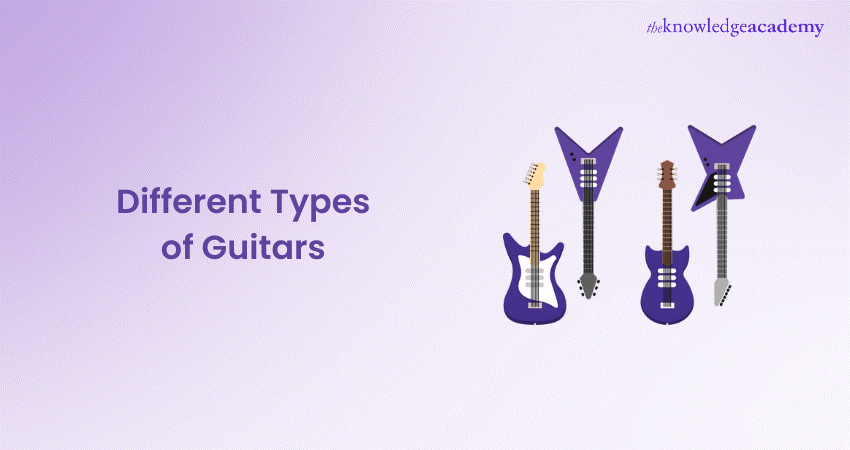
Guitars have played a crucial role in the world of music for centuries. They come in various shapes, sizes, and styles, each producing distinct sounds. Whether you're a seasoned guitarist or a beginner looking to start your musical journey, understanding the different Types of Guitars is crucial.
In this comprehensive blog, we'll explore 15 unique Types of Guitars, including their characteristics and uses. Let’s dive in to learn more!
Table of Contents
1) Types of Guitars
a) Resonator Guitars
b) Classical Guitars
c) Steel-string acoustics
d) Acoustic Guitars
e) Semi-acoustic Guitars
f) Electro-acoustic Guitars
g) Cousins of the guitar
h) Electric Guitars
i) Weird Guitars
j) 7-string Guitars
2) Conclusion
Types of Guitars
Now, let's dive deeper into the various Types of Guitars and their essential Guitar Parts, each with its unique characteristics and purposes. Whether you're a budding guitarist or simply curious about the world of music, this section will enlighten you about the diversity of Guitars available.
1) Resonator Guitars
Resonator Guitars are truly distinctive instruments in the world of music. They are renowned for their unique design, characterised by a metal cone or resonator plate built into the guitar's body. Let's explore some of the key features of Resonator Guitars:
1) Metal cone: Resonator Guitars have a metal cone placed inside the body, typically made of steel or aluminium. This cone serves as the primary sound-producing element, replacing the traditional soundhole found in acoustic Guitars.
2) Rich and twangy sound: The metal cone in resonator Guitars generates a bright and twangy sound, making them perfect for genres like blues, country, and folk music. Their distinct tonal quality adds a unique flavour to these musical styles.
3) Loud and projecting: Resonator Guitars are known for their volume and projection. The metal cone amplifies the sound, ensuring that even in larger venues, the guitar's tones are heard clearly.
4) Round neck vs. square neck: Resonator Guitars come in two main neck styles: round neck and square neck. Round-neck models are played like a regular guitar, while square-neck models are played horizontally on the lap with a slide, often used in blues and slide guitar playing.
2) Classical Guitars
Classical Guitars are renowned for their elegance and unique sound, making them a beloved choice among musicians, especially in classical and flamenco genres. Let's explore the key features of these exquisite instruments:
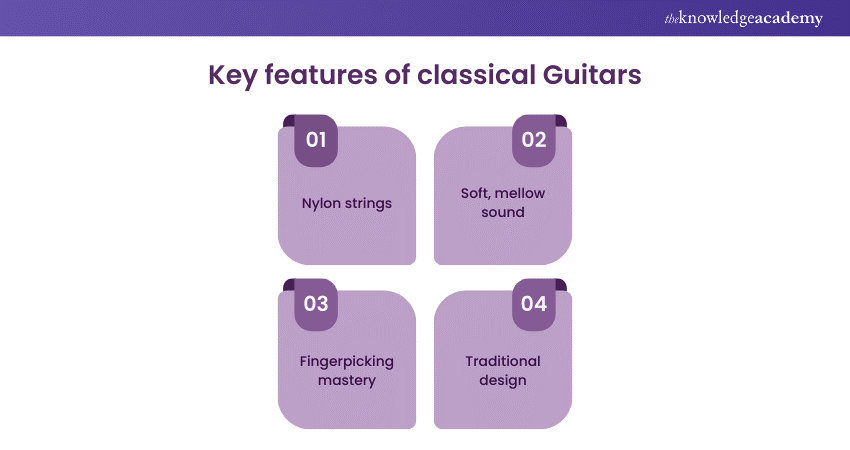
1) Nylon strings: Classical Guitars feature nylon strings, which produce a warm and melodic tone. They are easier on the fingers, making them perfect for beginners and fingerstyle players.
2) Soft, mellow sound: The nylon strings create a soft and mellow sound well-suited for classical compositions. This gentle tonality is also appreciated in flamenco music, which complements the passionate and percussive style of play.
3) Fingerpicking mastery: Classical guitarists often use fingerpicking techniques, emphasising precision and finger control. This style allows for intricate melodies and harmonies.
4) Traditional design: Classical Guitars typically have a vast, flat body and a slotted headstock, preserving the instrument's classical heritage.
Classical Guitars enchant listeners with their soothing melodies, making them a staple in the world of classical music. It is a preferred choice for those seeking to explore the beauty of fingerstyle playing.
3) Steel-string acoustics
Steel-string acoustic Guitars are popular among musicians for their versatility and distinctive sound. Here's an overview of their key characteristics:
1) Steel strings: Steel-string acoustics feature steel strings, offering a bright tone and durability.
2) Clear sound: They provide a clear and vibrant sound suitable for various genres.
3) Versatile styles: Ideal for strumming and flatpicking, accommodating both rhythm and melody.
4) Different body styles: Available in various body styles like dreadnought, concert, and jumbo, each with distinct tonal qualities.
Artists and songwriters favour steel-string acoustic Guitars for their live and studio versatility. This makes them a top choice for exploring diverse musical styles.
4) Acoustic Guitars
Acoustic Guitars, available in classical and steel-string variants, find versatile use in the music world. Acoustic Guitars are some of the most produced Types of Guitars by many Guitar Brands. Here are some of its key features:
1) Versatile performers: These Guitars are essential for intimate gatherings, campfire sing-alongs, and acoustic performances, adding warmth and authenticity to the music.
2) Nylon and steel strings: Acoustic Guitars offers both nylon and steel strings suitable for various musical styles. Nylon strings create a mellow sound ideal for classical and fingerstyle genres, while steel strings produce the brightness needed for folk, rock, and pop.
3) Across genres: Acoustic Guitars are the foundation of classical compositions, folk ballads, rock anthems, and pop melodies, making them indispensable for musicians exploring diverse genres.
4) Varied body shapes: Available in body shapes like dreadnought, concert, and parlour, each style offers a unique tone and comfort, catering to different playing preferences.
Acoustic Guitars serve as the soulful acoustic storytellers of the music world. They enable artists to create memorable moments and connect with their audiences across a wide spectrum of musical expressions.
5) Semi-acoustic Guitars
Semi-acoustic Guitars, also known as hollow-body Guitars, blend acoustic and electric elements. This makes them versatile instruments for various music genres. Let's explore some of them below:
1) Amplification with acoustic resonance: These Guitars have a hollow body that can be amplified. They produce a warm, resonant tone like acoustic Guitars when played unplugged.
2) Ideal for jazz and blues: Semi-acoustic Guitars are trendy in jazz and blues due to their rich, mellow tones. They excel in producing smooth and melodic sounds.
3) Feedback control: Musicians appreciate semi-acoustics for their feedback-resistant design, allowing for higher volumes without unwanted feedback, which is essential in live performances.
4) Versatile electric features: They also incorporate electric guitar elements such as pickups and tone controls, making them adaptable for various styles, including rock and fusion.
Semi-acoustic Guitars bridge the gap between the acoustic and electric worlds. This makes them a favoured choice among musicians who seek the best of both worlds and those looking to explore genres that demand rich, resonant tones.
Grab Your Guitar & Start Playing! Learn How to Play Guitar with Confidence.
6) Electro-acoustic Guitars
Electro-acoustic Guitars, sometimes called acoustic-electric Guitars, offer a combination of acoustic and electric capabilities. They cater to various musical styles, and let's explore some of them below:
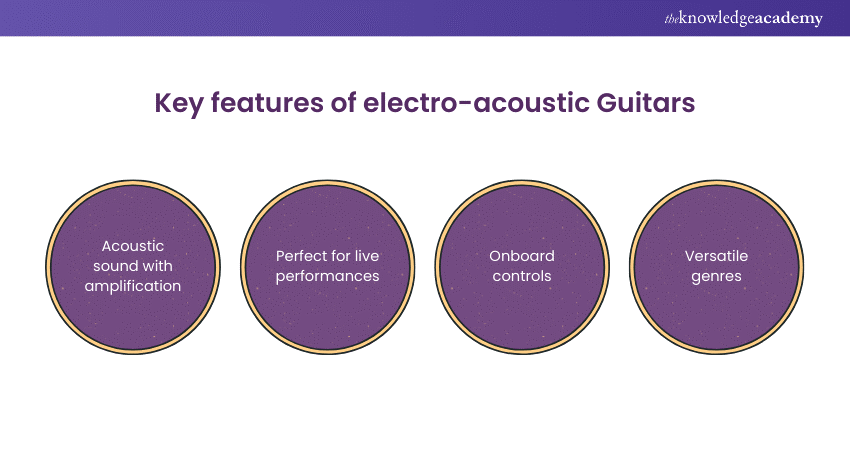
1) Acoustic sound with amplification: These Guitars maintain the pure acoustic sound of traditional acoustics but come equipped with built-in pickups and preamps for easy amplification and control.
2) Perfect for live performances: Electro-acoustic Guitars are a top choice for live performances. Musicians can connect them to amplifiers or sound systems, ensuring their acoustic nuances are heard in larger venues.
3) Onboard controls: They often feature onboard controls for volume, tone, and EQ adjustments, allowing artists to fine-tune their sound without relying solely on external equipment.
4) Versatile genres: These Guitars are versatile and can be used in various genres, from folk and rock to country and pop, thanks to their ability to deliver both acoustic warmth and amplified power.
Electro-acoustic Guitars provide the best of both acoustic and electric worlds, making them a preferred option for musicians who want the natural resonance of an acoustic instrument mixed with the convenience of amplification and versatile tone shaping.
7) Cousins of the guitar
Let's explore guitar-like instruments that share similarities in playing techniques and musical genres:
1) Banjo: The banjo, renowned for its unique twangy timbre, is prominent in bluegrass, folk, and country music genres. It features a round body and a unique resonator that produces its signature sound.
2) Ukulele: With its small size and cheerful tones, the ukulele is popular in Hawaiian music and has found its way into various genres, including pop and indie music. Its four nylon strings create a bright and lively sound.
3) Mandolin: The mandolin, known for its rich and melodic tones, finds widespread use in bluegrass, folk, and classical music genres. It resembles a small, eight-stringed guitar and uses intricate picking and strumming techniques.
Though not technically Guitars, these instruments share a musical kinship and have carved their niches in diverse genres, enriching the music world with their unique sounds.
Strum your way to musical excellence with our Ukulele Training – Sign up today
8) Electric Guitars
Electric Guitars have revolutionised the music world with their ability to produce a range of sounds, from clean and melodic to distorted and powerful. Here's a closer look at its key features:
1) Solid-body design: Electric Guitars typically have a solid body, which allows for sustain and feedback control. This design contributes to their versatility and iconic appearance.
2) Pickups and amplification: They are equipped with magnetic pickups that convert string vibrations into electrical signals. These signals are then amplified, giving electric Guitars their distinct sound.
3) Endless sound possibilities: Electric Guitars offer a vast array of sound-shaping options through tone and volume controls, pickup selection, and effects pedals. This versatility makes them essential in rock, metal, jazz, and various contemporary genres.
4) Iconic models: Electric Guitars come in various shapes and sizes, with iconic models like the Fender Stratocaster and Gibson Les Paul becoming symbols of rock and roll.
Electric Guitars have left an indelible mark on the music industry, enabling musicians to push sonic boundaries and create iconic riffs and solos. They remain at the forefront of innovation and artistic expression in modern music.
9) Weird Guitars
In this section, we will explore the unconventional world of weird Guitars that challenge traditional design and sound:
1) Double-neck Guitars: These Guitars feature two necks, often with different tunings. Musicians like Jimmy Page have used them for seamless transitions between sounds.
2) Flying V: With its V-shaped body, the Flying V is a striking and eccentric choice. Popularised by guitarists like Jimi Hendrix and Randy Rhoads, it's known for its edgy appearance.
3) Hollow body Guitars: Resonating with a unique, warm tone, hollow body Guitars, like the Gibson ES-335, offer a blend of acoustic and electric qualities.
4) Fan-Fret Guitars: Electric Guitars have left an indelible mark on the music industry, enabling musicians to push sonic boundaries and create iconic riffs and solos. They remain at the forefront of innovation and artistic expression in modern music.
5) Steinberger Headless Guitars: Primarily known for their futuristic appearance, these Guitars have no headstock. They're compact, lightweight, and favoured by musicians looking for a unique stage presence.
Weird Guitars pushes the boundaries of design and sound, appealing to adventurous musicians who seek distinctive instruments to enhance their musical expression.
10) 7-string Guitars
7-string Guitars are the choice of many musicians seeking to push the boundaries of their music. They offer deeper tones and expanded sonic possibilities, creating a fresh and exciting musical journey. Let's explore its key features:
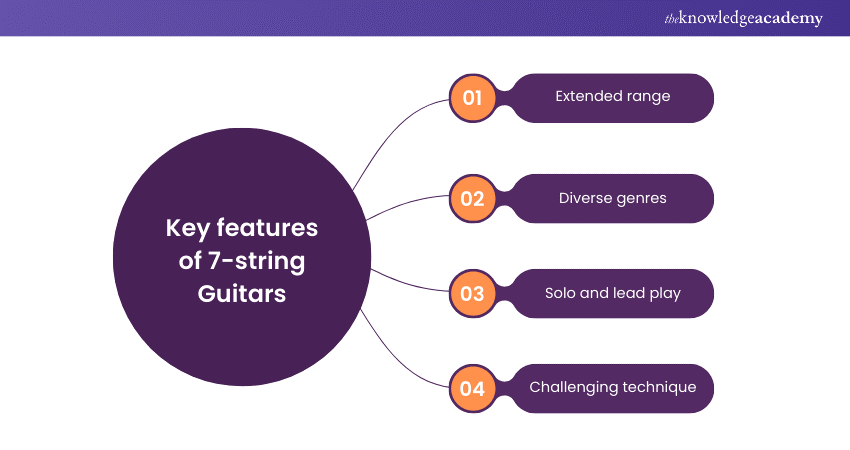
1) Extended range: 7-string Guitars feature an additional low B string, extending the instrument's tonal range below the traditional 6-string guitar.
2) Diverse genres: These Guitars are popular in various music genres, including metal, jazz, fusion, and progressive rock, where the added string allows for deeper, heavier riffs and complex chord voicings.
3) Solo and lead play: Musicians appreciate 7-string Guitars for their versatility in both rhythm and lead playing. The extra string enhances soloing capabilities and provides more options for creative expression.
4) Challenging technique: Playing a 7-string guitar can be difficult due to the broader fretboard, but it offers unique opportunities for experimentation and innovation.
Elevate your musical creativity with our Music Composition Course – Sign up today!
11) 12-string acoustics
12-string acoustic Guitars are cherished for their distinctive sound and ability to add a touch of magic to various musical genres. Music Production Equipment remains a favoured choice for artists looking to create a sonically enchanting experience. Here are some of its key features:
1) Double strings: 12-string acoustics feature double strings for each of the six standard strings. This pairing creates a lush, chorus-like effect and a fuller, richer sound.
2) Rich harmonies: The doubled strings produce natural choruses and harmonies, making 12-string acoustics perfect for folk, rock, and acoustic ballads.
3) Fingerstyle brilliance: Musicians often use 12-strings for fingerstyle playing, as they can easily create intricate melodies and rich harmonics.
4) Unique tonal palette: These Guitars offer an exceptional tonal palette, adding depth and character to recordings and live performances.
12) Solid-body electric Guitars
Solid-body electric Guitars are renowned for their versatility and distinctive sound in the world of music. Let's explore some of their key features:
1) Sustain and feedback control: Solid body design allows for extended sustain and better feedback control, essential for techniques like bending and vibrato.
2) Endless sound customisation: These Guitars come equipped with various pickups, tone knobs, and switches, offering a wide range of tonal possibilities, from clean and crisp to heavy and distorted.
3) Ideal for high-gain genres: Solid-body electric Guitars are a staple in rock, metal, and punk music. This is mainly due to their ability to handle high-gain amplification and produce powerful, driven tones.
4) Iconic models: They include iconic models like the Fender Stratocaster and Gibson Les Paul, which have left an indelible mark on the music industry.
13) Lapsteel/pedal steel
Lap steel and pedal steel Guitars offer a unique and distinctive sound and fascinating playing techniques. These instruments have deep roots in country and Hawaiian music, contributing to these genres' signature twang and expressive sounds. Let's delve into their captivating world and explore their characteristics and versatility.
1) Horizontal playing: Lap steel Guitars are played flat on the player's lap, using a slide or steel bar to create smooth, gliding tones.
2) Pedal control: Pedal steel Guitars take it a step further with foot pedals and knee levers that change the pitch of certain strings, allowing for intricate and emotive bends and slides.
3) Country and Hawaiian roots: These Guitars have deep roots in country and Hawaiian music, contributing to these genres' signature twang and expressive sounds.
4) Versatile expressiveness: Lap steel and pedal steel Guitars are prized for their ability to convey a wide range of emotions, from wistful and melancholic to upbeat and joyful.
These instruments offer a unique sonic experience and mastering them requires a special skill set that adds a distinctive flavour to the world of music.
14) Nylon-string classical
Nylon-string classical Guitars find diverse applications in the world of music due to their unique characteristics. Here are some of its use cases:
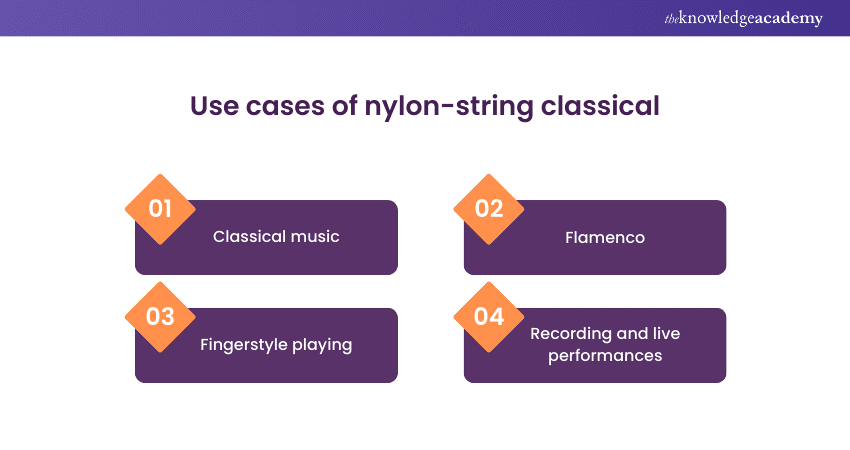
1) Classical music: These Guitars are indispensable in classical music, where their warm and melodic tones perfectly complement the intricate compositions and fingerpicking techniques.
2) Flamenco: Nylon-string classical Guitars play a vital role in flamenco music, contributing to the passionate and percussive style of play that defines this genre.
3) Fingerstyle playing: Musicians of various genres, including folk, jazz, and world music, use classical Guitars for fingerstyle playing, thanks to their gentle tonality and excellent finger control.
4) Recording and live performances: Classical Guitars are a popular choice for both studio recordings as well as live performances. They offer a soothing and expressive sound that captivates audiences.
Nylon-string classical Guitars serve as versatile instruments, enhancing the musicality and emotional depth of various genres and settings.
Explore the world of music with our Music Production Course – Sign up now!
15) Bass
Bass Guitars serve as music's rhythmic and harmonic backbone, anchoring melodies with their deep tones. Let's delve into the world of bass Guitars and their crucial role in various music genres:
1) The foundation of the band: Bass Guitars provide a band's fundamental groove and rhythm, forming a strong foundation for other instruments to build upon.
2) Diverse styles: From funk and jazz to rock and reggae, bass Guitars are versatile, adapting to various musical styles with their thumping, resonant notes.
3) Four and five-string options: Basses come in four and five-string variants, with the fifth string extending the lower range, offering more options for creative basslines.
4) Slap and fingerstyle techniques: Bassists use techniques like slap and fingerstyle playing to create unique tones and rhythms, adding depth to compositions.
Bass Guitars are essential in creating the heartbeat of music, and their skilled players are celebrated for their ability to groove and drive a song's energy.
Conclusion
We hope you read and understand everything about the different Types of Guitar. From classical elegance to electric versatility and rhythmic bass, these instruments offer endless possibilities for musical expression. Whether you're a seasoned player or an aspiring musician, Guitars remain a source of inspiration and creativity in the music world.
Become a renowned Guitarist with the help of our Guitar Course – Sign up now!
Frequently Asked Questions
What's the difference between an acoustic and an electric guitar?

An acoustic guitar is hollow-bodied and produces sound acoustically, while an electric guitar has a solid body and requires amplification to be heard. Acoustics offer a natural tone, ideal for folk and unplugged settings, while electrics provide versatility and are favoured in rock and jazz genres.
Can I use nylon strings on an electric guitar?

Using nylon strings on an electric guitar designed for steel strings is not recommended. The tension difference can lead to intonation and playability issues. Nylon strings are primarily intended for classical Guitars with a different build and neck design that complements their characteristics.
What are the other resources and offers provided by The Knowledge Academy?

The Knowledge Academy takes global learning to new heights, offering over 3,000 online courses across 490+ locations in 190+ countries. This expansive reach ensures accessibility and convenience for learners worldwide.
Alongside our diverse Online Course Catalogue, encompassing 19 major categories, we go the extra mile by providing a plethora of free educational Online Resources like News updates, Blogs, videos, webinars, and interview questions. Tailoring learning experiences further, professionals can maximise value with customisable Course Bundles of TKA.
What is Knowledge Pass, and how does it work?

The Knowledge Academy’s Knowledge Pass, a prepaid voucher, adds another layer of flexibility, allowing course bookings over a 12-month period. Join us on a journey where education knows no bounds.
What are the related Hobbies and Interests courses and blogs provided by The Knowledge Academy?

The Knowledge Academy offers various Hobbies and Interests Courses including Guitar Training, Piano Course, and Filmmaking Masterclass. These courses cater to different skill levels, providing comprehensive insights into the Careers in Music Production.
Our Business Skills Blogs cover a range of topics related to online Businesses, offering valuable resources, best practices, and industry insights. Whether you are a beginner or looking to advance your Business skills, The Knowledge Academy's diverse courses and informative blogs have you covered.
Upcoming Business Skills Resources Batches & Dates
Date
 Guitar Course
Guitar Course
Fri 13th Jun 2025
Fri 15th Aug 2025
Fri 10th Oct 2025
Fri 12th Dec 2025






 Top Rated Course
Top Rated Course



 If you wish to make any changes to your course, please
If you wish to make any changes to your course, please


